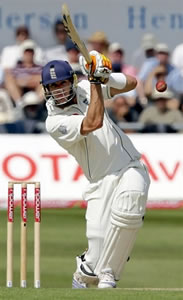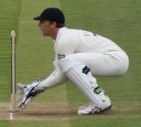KP to return to dominance in New Zealand
Paul Wood |
“My view is that once he goes through his failure period then this will be the making of KP”, so wrote Shane Warne in the foreword of Kevin Pietersen’s autobiography, Crossing the Boundary.
There will inevitably come a time when Pietersen finds it difficult to replicate his outstanding Test career form to date. His eccentric strokeplay, which involves reverse sweeping for six, arrogantly manipulating the ball from six inches or more outside his off stump through straight mid-wicket and his general contempt for the bowler, will all come under severe scrutiny. In some parts these will be seen as the reasons for a slump, with people quickly forgetting how they cheered such strokes when they were perfectly executed. Only journalists and spectators can have it both ways.
As Warne suggests and history demands, the runs will dry up for a time at some stage. Following his disappointing tour of Sri Lanka, Pietersen will be determined that that time is not now.
He has struggled to recapture his fluency on the low, slow wickets of the sub-continent. It was the first time he went through a Test series without registering a half century and an average of only 25.20 was all he had to show for his efforts.
It is easily forgotten the success that KP enjoyed through 2007, even allowing for his rather fruitless tour of Sri Lanka. He was one of only three Test batsmen to pass 1,000 runs for the year – Jacques Kallis 1,210 runs and Sourav Ganguly 1,106 led the way – at an average of over 50.
Of course his runs will not always be scored in the scintillating fashion that he is so associated with and it may be the times when he has to dig in with conditions favouring the bowler that will continue to take his game to another level. We saw it in the recent Australia versus India series when Australia skipper Ricky Ponting was made to work very hard for his runs in Adelaide following a disappointing start to the series by his standards. He adapted to the situation and the needs of his side and stuck in to make 140 dogged runs, without his usual flow of pulls, drives and cuts.
We know Pietersen is also capable of such feats, he described his century against India at Lords last year as “right out of the top drawer”, he even went as far as to say “I’d probably rate that as No. 1 to be totally honest”. This was in testing conditions, the ball was moving around and India, led by the impressive duo of RP Singh and Zaheer Khan, bowled superbly. Everybody knows what KP is capable of when he is on top of the attack with the ball coming nicely onto the bat, and in New Zealand he will find conditions much more in keeping with his style than in the sub-continent. Brought up on the pacy, bouncy tracks of South Africa and having honed his technique on tracks that offer bowlers ample assistance in England, the New Zealand pitches are unlikely to deter his dominance.
I feel the cricketing public in general are the ones that are punished from Shane Bond’s absence, his duel against Kevin Pietersen would have been an absorbing one. If Pietersen was to succeed, there will have been times where he would have to give ground to the bowler, recognise and accept when Bond is in the middle of a good spell and simply bide his time and keep his wicket intact, although it may not be common practice for Pietersen to do so. Bond will undoubtedly be missed, and while it will be a mistake to underestimate the Kiwi attack, it does happen to be one of the weakest on the international circuit.
Pietersen though, appears to be firmly focused on the job in hand. When recently quizzed about the Ashes in 2009, he rightly stated there are five big series before then, and five series that demand full concentration if England are to build any momentum heading into 2009.
While there is expected to be enough movement in the tracks to encourage the quicker bowlers, batsman will reap the rewards once they get set. It is widely acknowledged that Pietersen is at his best when he takes his time and builds his innings without risking too many expansive strokes too early.
He will have a score to settle in relation to one-day cricket. During the last tour to Sri Lanka, his average dropped below 50 for the first time in his career. He had mixed success in 2007 in the 50-over game, his quality was there for all to see in the World Cup, but since the prestigious tournament he has struggled to take control of matches like he did so frequently earlier in his career, despite playing a decisive innings in the final ODI against India last year.
He entered the World Cup with a strike rate just under 95 and even after his successful tournament, it has dropped to 88.29 runs per 100 balls, which is admittedly no disgrace, but perhaps an indication that he has struggled to dominate attacks recently or has he undergone a change in mindset, only too aware of how important his wicket is to the side. Either way, his average of 30.25 since the World Cup indicates he is lacking form in the one-day arena.
Kevin Pietersen will be keen to address his recent disappointments. Great players use their resources and hit back strongly. In New Zealand, Pietersen will face an attack not at its strongest and he will prey on any hesitancy, his positive style ensuring the pressure is forced onto the bowler and they cannot afford to be anything other than at their best if they want to trouble KP. The battle with Vettori promises to be the most intriguing viewing.
With everything taken into consideration, the failure period that Shane Warne talked about may be on hold for the time being at least.




Leave a comment